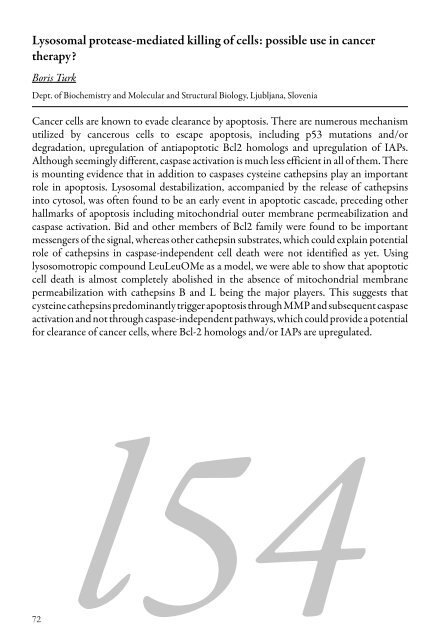Create successful ePaper yourself
Turn your PDF publications into a flip-book with our unique Google optimized e-Paper software.
Lysosomal protease-mediated killing <strong>of</strong> cells: possible use in cancer<br />
therapy?<br />
Boris Turk<br />
Dept. <strong>of</strong> Biochemistry and Molecular and Structural Biology, Ljubljana, Slovenia<br />
Cancer cells are known to evade clearance by apoptosis. There are numerous mechanism<br />
utilized by cancerous cells to escape apoptosis, including p53 mutations and/or<br />
degradation, upregulation <strong>of</strong> antiapoptotic Bcl2 homologs and upregulation <strong>of</strong> IAPs.<br />
Although seemingly different, caspase activation is much less efficient in all <strong>of</strong> them. There<br />
is mounting evidence that in addition to caspases cysteine cathepsins play an important<br />
role in apoptosis. Lysosomal destabilization, accompanied by the release <strong>of</strong> cathepsins<br />
into cytosol, was <strong>of</strong>ten found to be an early event in apoptotic cascade, preceding other<br />
hallmarks <strong>of</strong> apoptosis including mitochondrial outer membrane permeabilization and<br />
caspase activation. Bid and other members <strong>of</strong> Bcl2 family were found to be important<br />
messengers <strong>of</strong> the signal, whereas other cathepsin substrates, which could explain potential<br />
role <strong>of</strong> cathepsins in caspase-independent cell death were not identified as yet. Using<br />
lysosomotropic compound LeuLeuOMe as a model, we were able to show that apoptotic<br />
cell death is almost completely abolished in the absence <strong>of</strong> mitochondrial membrane<br />
permeabilization with cathepsins B and L being the major players. This suggests that<br />
cysteine cathepsins predominantly trigger apoptosis through MMP and subsequent caspase<br />
activation and not through caspase-independent pathways, which could provide a potential<br />
for clearance <strong>of</strong> cancer cells, where Bcl-2 homologs and/or IAPs are upregulated.<br />
72<br />
l54
















